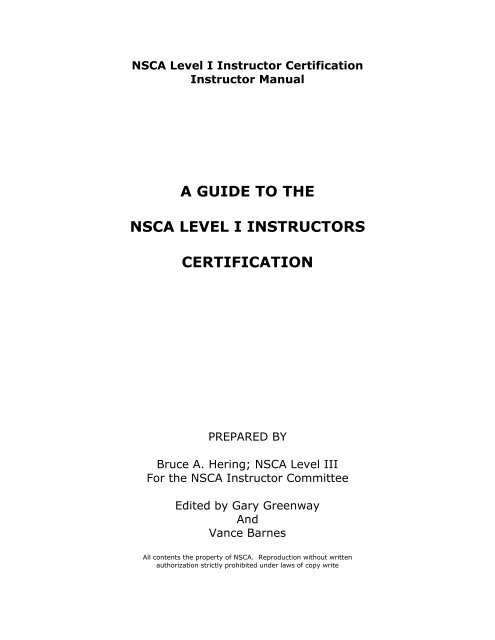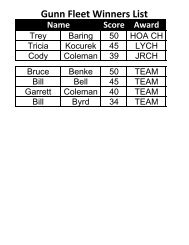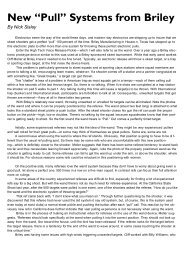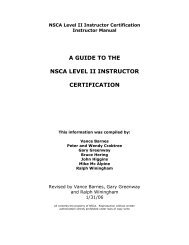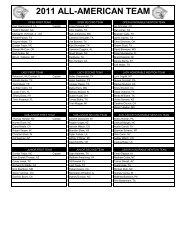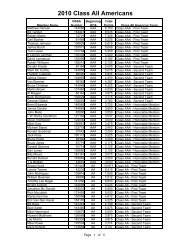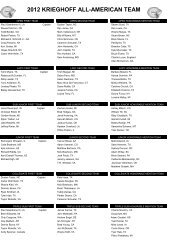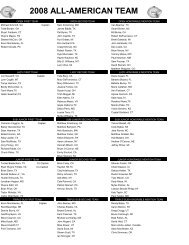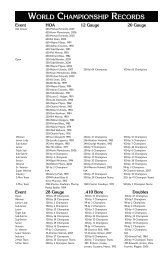a guide to the nsca level i instructors certification - NSSA-NSCA
a guide to the nsca level i instructors certification - NSSA-NSCA
a guide to the nsca level i instructors certification - NSSA-NSCA
Create successful ePaper yourself
Turn your PDF publications into a flip-book with our unique Google optimized e-Paper software.
<strong>NSCA</strong> Level I Instruc<strong>to</strong>r Certification<br />
Instruc<strong>to</strong>r Manual<br />
A GUIDE TO THE<br />
<strong>NSCA</strong> LEVEL I INSTRUCTORS<br />
CERTIFICATION<br />
PREPARED BY<br />
Bruce A. Hering; <strong>NSCA</strong> Level III<br />
For <strong>the</strong> <strong>NSCA</strong> Instruc<strong>to</strong>r Committee<br />
Edited by Gary Greenway<br />
And<br />
Vance Barnes<br />
All contents <strong>the</strong> property of <strong>NSCA</strong>. Reproduction without written<br />
authorization strictly prohibited under laws of copy write
Table of Contents<br />
Page 3 Mission Statement and entry criteria<br />
Page 4 Cost<br />
Page 4 <strong>NSCA</strong> Philosophy of Instruction<br />
Page 6 Objectives of <strong>the</strong> Level I Certification Course<br />
Page 10 Safety<br />
Page 12 Control of Firearm<br />
Page 14 Identifying Causes and Placement of miss on Target<br />
Page 17 Lead and Lead types<br />
Page 21 Problem Solving or “Get <strong>the</strong> student <strong>to</strong> hit <strong>the</strong> target.”<br />
Page 23 Gun Fit<br />
Page 24 Eye Dominance<br />
Page 26 Stance<br />
Page 27 Beginner Targets and Shooter Ability<br />
Page 28 Chokes and Loads<br />
Page 29 Observation, Motivation and Communication Skills<br />
Page 32 Lesson Plan<br />
2
Mission Statement<br />
The instruc<strong>to</strong>r committee is dedicated <strong>to</strong> all <strong>level</strong>s of shooting,<br />
stressing safety first, as well as an environment with an entertaining<br />
and noncomplex agenda. The Instruc<strong>to</strong>r Certification Committee will<br />
stress quality and experience in Level II & III instruc<strong>to</strong>rs, not quantity.<br />
The committee will also promote continuing education for all<br />
instruc<strong>to</strong>rs.<br />
Level I<br />
Entry Guidelines and Criteria<br />
Applicants must be members in good standing of <strong>NSCA</strong>.<br />
Applicants should be minimally eighteen (18) years of age and have<br />
had at least two (2) years of shooting experience.<br />
Candidates are expected <strong>to</strong> be comfortable working with shooting<br />
students in a one-on-one situation and have a desire <strong>to</strong> function<br />
effectively in <strong>the</strong> role of teacher. Candidates must have <strong>the</strong> ability <strong>to</strong><br />
empathize with <strong>the</strong>ir student’s situation. Previous teaching experience<br />
(e.g. Boy Scout or 4H Leader, sports coaching, or something similar) is<br />
helpful but not required.<br />
Candidates must demonstrate a complete knowledge of and comply<br />
with shooting range safety pro<strong>to</strong>cols. Only a 100% safe shooting<br />
environment will be acceptable. Candidates are solely responsible for<br />
<strong>the</strong>ir personal safety, <strong>the</strong> safety of <strong>the</strong>ir students, and <strong>the</strong> safety of<br />
range personnel. The ability <strong>to</strong> pay attention <strong>to</strong> every detail is<br />
manda<strong>to</strong>ry.<br />
3
COST<br />
$500 plus target and instruc<strong>to</strong>r expenses. Instruc<strong>to</strong>r expenses will<br />
vary with target and travel costs.<br />
THE <strong>NSCA</strong> PHILOSOPHY OF INSTRUCTION<br />
The <strong>NSCA</strong> instruction model is built on and supported by educational<br />
research. Virtually every individual learns at an improved rate and<br />
retains more of what <strong>the</strong>y have been exposed <strong>to</strong> through experiential<br />
(hands-on) and interactive learning strategies. “Telling” simply is not<br />
an efficient, effective teaching method. This model is used both as a<br />
working entity for <strong>the</strong> purpose of “Training <strong>the</strong> Trainer”, (<strong>the</strong> instruc<strong>to</strong>r<br />
candidate) and also as a <strong>guide</strong> for teaching strategies for that<br />
candidate.<br />
A large majority of individuals learn best by repetitive activity. This is<br />
known as tactile-kines<strong>the</strong>tic learning and is particularly common in <strong>the</strong><br />
educational genre of psychomo<strong>to</strong>r objectives i.e., skills need <strong>to</strong> be<br />
learned through personal trial and error. Ano<strong>the</strong>r group of learners<br />
are best stimulated by visually observing (visual learners). Still a<br />
third, but relatively small group, learns by listening (audi<strong>to</strong>ry). A<br />
fourth and certainly very small group, learns by reading or visual<br />
cognitive modality. A highly effective instruc<strong>to</strong>r must be competent in<br />
utilizing all four areas.<br />
You, <strong>the</strong> instruc<strong>to</strong>r candidate, will have ample time <strong>to</strong> practice <strong>the</strong><br />
<strong>NSCA</strong> teaching model. As will be seen, much of <strong>the</strong> art and science of<br />
teaching is learning <strong>to</strong> ask questions of your students in order <strong>to</strong> find<br />
<strong>the</strong> correct teaching <strong>to</strong>ol. Simply telling a student what you see will<br />
not result in effective teaching. Learning <strong>to</strong> shoot a shotgun well is<br />
best accomplished by a student and instruc<strong>to</strong>r learning <strong>to</strong><br />
communicate and cooperate <strong>to</strong> solve each problem.<br />
Effective communication often requires creativity. As an example, and<br />
<strong>to</strong> assist you in fostering creativity in teaching, you may be asked <strong>to</strong><br />
instruct a student without talking at all. Silent communication of an<br />
instructional concept as complex as hitting a target may not be as<br />
difficult as one might think and certainly demonstrates that all method<br />
teaching need not be “how <strong>to</strong> shoot.”<br />
4
Successful completion of this course will entitle you <strong>to</strong> advertise<br />
yourself as a Certified Level I <strong>NSCA</strong> Instruc<strong>to</strong>r and seek clients for<br />
your instructional services. Level I instruc<strong>to</strong>rs are only certified <strong>to</strong><br />
teach beginning and novice shooters. Level I instruc<strong>to</strong>rs who wish <strong>to</strong><br />
receive training <strong>to</strong> coach intermediate <strong>level</strong> shooters are encouraged<br />
<strong>to</strong> attend and complete <strong>the</strong> <strong>NSCA</strong>’s Level II Instruc<strong>to</strong>r Certification<br />
course upon completion or attainment of that <strong>certification</strong>’s<br />
prerequisites.<br />
5
Objectives of <strong>the</strong> Level I Instruc<strong>to</strong>r Certification<br />
Course<br />
Objective: Level I Instruc<strong>to</strong>r Certification<br />
Candidate will demonstrate exact knowledge of safety procedures.<br />
(Cognitive domain)<br />
A. Hearing and eye protection<br />
B. Proper range safety and etiquette<br />
C. Firearm operations<br />
D. Firearm and ammunition malfunctions<br />
E. Recognize potential safety hazards<br />
Candidate will demonstrate ability <strong>to</strong> control student’s firearm in<br />
teaching situation. (Cognitive, Affective, Psychomo<strong>to</strong>r Domains)<br />
A. Right hand/left hand<br />
B. In cage/out of cage<br />
C. Young adult<br />
D. Ammunition<br />
Candidate will, on target, correctly identify cause and placement of<br />
students miss. (Cognitive, Affective and Psychomo<strong>to</strong>r Domains)<br />
A. Observation of shot string or pattern<br />
B. “Reading <strong>the</strong> barrel” method<br />
This will also entail identifying <strong>the</strong> reason for <strong>the</strong> miss such as:<br />
A. Failure <strong>to</strong> look at target.<br />
1. Primary focus shifted from target.<br />
B. Head off gun<br />
C. Poor mount<br />
D. Wrong lead picture<br />
E. Pain<br />
F. Bad stance<br />
G. Gun fit<br />
6
Candidate will demonstrate ability <strong>to</strong> identify and teach <strong>the</strong> three<br />
primary (as well as modifications <strong>the</strong>re of) lead types used by and<br />
taught <strong>to</strong> students. (Cognitive, Psychomo<strong>to</strong>r Domains)<br />
A. Pull Away<br />
B. Pass through<br />
C. Sustained<br />
Candidate will demonstrate (objectively and subjectively) proficiency<br />
at Level I ability in outcome based solution/resolution <strong>to</strong> students<br />
ability <strong>to</strong> hit targets. (i.e. demonstrate <strong>the</strong> ability <strong>to</strong> solve problems,<br />
thinking on <strong>the</strong>ir feet, thinking outside <strong>the</strong> box)<br />
A. Problem solving skills<br />
1. Skills for youth<br />
a. Watch intimidation<br />
b. Not <strong>to</strong>o technical<br />
2. Skills for adults<br />
a. Watch intimidation<br />
b. Use information <strong>the</strong>y know<br />
B. Interpersonal communication skills<br />
1. Skills for youth<br />
a. Do not talk condescendingly<br />
b. Do not try and talk <strong>the</strong>ir language<br />
c. Do not give <strong>the</strong>m a “brain dump” of<br />
information.<br />
2. Skills for adults<br />
a. Watch and interpret body language<br />
b. Engage in conversation <strong>the</strong>y can<br />
understand.<br />
c. Do not overload <strong>the</strong> “fix”.<br />
The acceptance of <strong>the</strong>se teaching types is based mostly<br />
in <strong>the</strong> Affective Domain in that <strong>the</strong> students, both <strong>the</strong><br />
Instruc<strong>to</strong>r candidate and <strong>the</strong> shooting learner, must want <strong>to</strong><br />
accept <strong>the</strong> basic information presented. This<br />
is known as “Acceptance of Value.”<br />
A. Socratic<br />
B. Communicative<br />
C. Visual<br />
D. Verbal<br />
E. Cognitive<br />
7
F. Psycho-mo<strong>to</strong>r<br />
G. Repetitive<br />
H. Demonstration<br />
It should be unders<strong>to</strong>od that this section, though never<br />
complete, will apply <strong>to</strong> all objectives in this course.<br />
Candidate will, via provision of information <strong>to</strong> <strong>the</strong> certifiers,<br />
demonstrate recognition of proper fit of shotgun <strong>to</strong> shooter.<br />
A. Length of pull<br />
B. Cast<br />
C. Drop<br />
D. Pitch<br />
E. The female shooter<br />
At Level I we should be interested in BASIC fit. Correcting a<br />
minor fit flaw is fine; however we should leave <strong>the</strong> true fitting <strong>to</strong><br />
those who know how <strong>to</strong> do it well.<br />
This operation, though mechanical in domain is very oriented <strong>to</strong><br />
upper <strong>level</strong> cognitive thought.<br />
Candidate will demonstrate one or more methods of determining<br />
shooters dominant eye as well as corrective measures.<br />
A. Candidate will check several students for eye<br />
dominance using a choice of methods.<br />
Correction:<br />
1. Tape<br />
2. Gel<br />
3. Lip balm<br />
4. Change shoulders<br />
5. What <strong>to</strong> do with <strong>the</strong> co-eye dominant<br />
shooter<br />
We all know <strong>the</strong>re will be eye dominance problems.<br />
Our ability <strong>to</strong> creatively adapt <strong>the</strong> student means <strong>the</strong> difference<br />
between success and failure.<br />
Caution must be used here so as not <strong>to</strong> make <strong>the</strong> student feel<br />
like <strong>the</strong>y are different in a negative manner.<br />
8
Candidate will recognize and instruct proper shooting stance for<br />
various basic target presentations relevant <strong>to</strong> high gun and low gun<br />
start.<br />
A. Feet<br />
B. Gun hold<br />
1. Start point<br />
2. Insert point<br />
3. Break point<br />
4. Follow through<br />
C. Mount<br />
1. Pre mount for beginner<br />
2. Transition stage<br />
3. Low gun/Out of shoulder<br />
It is best <strong>to</strong> start a beginner at high gun in order <strong>to</strong> remove<br />
some possible mistake or faults. It is felt that <strong>the</strong>re is a<br />
transition stage between <strong>the</strong> pre- mounted gun and low gun.<br />
This is an area which has been dealt with very little. The mount<br />
itself should be based on student ability.<br />
This is a demonstration area that deals with psychomo<strong>to</strong>r<br />
ability. It should be tactile-kines<strong>the</strong>tic. i.e. Repeat, repeat,<br />
repeat. It is eye, muscle memory based.<br />
Candidate will demonstrate selection and presentation of targets for<br />
beginner and novice shooter. (Affective, psychomo<strong>to</strong>r domains)<br />
A. High, floating incomer<br />
B. Slow crossing rabbit<br />
C. Medium power straight away<br />
D. Ability on all of <strong>the</strong>se <strong>to</strong> modify shooters position<br />
Candidate will demonstrate mid-<strong>level</strong> operational knowledge of<br />
gauges, chokes and loads as <strong>the</strong>y pertain <strong>to</strong> clay shooting.<br />
A. Choke dimensions based on bore<br />
B. Types of chokes<br />
C. Ammunition types, manufacturers<br />
D. Gauges<br />
9
OBJECTIVE: <strong>NSCA</strong> Level I;<br />
SAFETY<br />
There are no simple steps or quick fixes regarding safety. One lax<br />
moment and disaster is waiting <strong>to</strong> strike. This becomes even truer<br />
during an instruction session.<br />
As an instruc<strong>to</strong>r candidate, think about <strong>the</strong> scenario you are playing a<br />
part in:<br />
You and a student are on <strong>the</strong> range for a lesson. Just that fact<br />
plays a role. The student is dividing <strong>the</strong>ir concentration between<br />
listening <strong>to</strong> you and attempting <strong>to</strong> take targets. That division of<br />
concentration, even with an experienced shooter, can be <strong>the</strong><br />
basis for a safety problem.<br />
The primary rules of gun, range and instruc<strong>to</strong>r safety:<br />
A. Always keep firearm pointed in a safe direction<br />
B. Treat every gun as if it were loaded<br />
C. Never mix shot shell ammo gauges<br />
1. Instruc<strong>to</strong>rs will control ammo while<br />
teaching beginners.<br />
D. Visually inspect chamber and barrel for obstructions<br />
E. Keep finger off trigger until target is called for<br />
F. Whenever possible, students should shoot from inside<br />
a stand or cage.<br />
G. All shotgun actions are <strong>to</strong> be kept open when firearm is<br />
in hand and student is not in cage. Actions may be<br />
closed on Over/Under shotguns when <strong>the</strong>y are in a gun<br />
rack. Au<strong>to</strong> and pump actions should be kept open.<br />
H. Instruc<strong>to</strong>r must stay within arms reach of <strong>the</strong><br />
student. This proximity is particularly important if <strong>the</strong><br />
instruc<strong>to</strong>r is working without a cage.<br />
10
I. Eye and ear protection are manda<strong>to</strong>ry.<br />
1. Instruc<strong>to</strong>rs should understand that <strong>the</strong>re is<br />
a difference in lens type between safety<br />
lenses and plain eyewear.<br />
2. Hearing protection should be maximized but<br />
not so cumbersome as <strong>to</strong> reduce <strong>the</strong> students<br />
ability <strong>to</strong> function.<br />
Every instruc<strong>to</strong>r should have a safety plan. This amounts <strong>to</strong> a mental<br />
notebook regarding what <strong>to</strong> do in each shooting situation. Instruc<strong>to</strong>rs<br />
should be well versed in <strong>the</strong> methods of controlling student’s gun<br />
movement. Always inspect a new student’s firearm prior <strong>to</strong> beginning<br />
<strong>the</strong> shooting part of <strong>the</strong> lesson. Some students will come <strong>to</strong> a lesson<br />
with ei<strong>the</strong>r a borrowed gun or perhaps one that has been in s<strong>to</strong>rage<br />
for some time. A quick look can save <strong>the</strong> day. “Ole Betsy could have<br />
a charge in her.”<br />
Talk with <strong>the</strong> student regarding <strong>the</strong> primary rules of gun safety.<br />
Then, talk with <strong>the</strong> student about <strong>the</strong> primary rules of gun<br />
safety……. Ad infinatum Always control <strong>the</strong> ammunition when<br />
instructing beginning students. This means you, <strong>the</strong> instruc<strong>to</strong>r, need<br />
<strong>to</strong> carry <strong>the</strong> ammunition and issue it shot by shot. Should you be in<br />
<strong>the</strong> position of instructing two students shooting different gauges (try<br />
and prevent this if you can) have two very distinct shooting bags <strong>to</strong><br />
keep <strong>the</strong> ammo separated.<br />
An area of safety that is sometimes downplayed regards what <strong>to</strong> do in<br />
<strong>the</strong> case of a misfire. First, you, as an instruc<strong>to</strong>r, should understand<br />
that reloaded ammunition is a risk which should be avoided. The risks<br />
of a misfire and or barrel obstruction are increased many fold in such<br />
cases. Always have your students use “fac<strong>to</strong>ry” ammo. In <strong>the</strong> case of<br />
a misfire, and yes, even fac<strong>to</strong>ry ammo can misfire; <strong>the</strong> firearm must<br />
be maintained in a muzzle safe direction. Wait at least thirty (30)<br />
seconds before opening <strong>the</strong> action. This should cover you in case of a<br />
“fizzle/hang fire.”<br />
Students will come <strong>to</strong> a lesson with a variety of firearms. <strong>NSCA</strong> does<br />
not want a novice student shooting an exposed hammer gun. The<br />
potential for a “drop fire” even given <strong>the</strong> intercep<strong>to</strong>rs commonly found<br />
on new made guns is great. This is not a responsibility you need <strong>to</strong><br />
worry about, so avoid if possible.<br />
11
The instruc<strong>to</strong>r should discuss with <strong>the</strong> student <strong>the</strong> safe operation of<br />
<strong>the</strong> type of firearm <strong>the</strong> student has brought <strong>to</strong> <strong>the</strong> lesson. Should <strong>the</strong><br />
instruc<strong>to</strong>r be supplying <strong>the</strong> firearm, <strong>the</strong> same will hold true.<br />
Remember this: You are ultimately <strong>the</strong> person in control. Your<br />
student must obey your rules regarding safety or go home. No<br />
ifs, ands or buts!<br />
OBJECTIVE: <strong>NSCA</strong> Level I,<br />
CONTROL OF FIREARM<br />
Perhaps one of <strong>the</strong> most important areas of concern for <strong>the</strong> certified<br />
instruc<strong>to</strong>r when working with new and young shooters is <strong>the</strong><br />
exuberance that can be displayed when a shot is successfully made.<br />
We have all stressed that this “lesson thing” should be fun and that<br />
it should. However, <strong>the</strong>re will be times when <strong>the</strong> emotional energy of<br />
a successful shot has <strong>to</strong> be released and it is at those times you as <strong>the</strong><br />
instruc<strong>to</strong>r must be in a position <strong>to</strong> take control of <strong>the</strong> firearm. A<br />
student makes a shot and in his or her joy turns around with gun in<br />
hand.<br />
Whoops!<br />
Is it empty or what? That was not supposed <strong>to</strong> happen!<br />
Well it did and it does. What do you do? Hopefully, you were in<br />
position and alert enough <strong>to</strong> prevent this from happening.<br />
This is not <strong>to</strong> say that <strong>the</strong>se are <strong>the</strong> only times when you might need<br />
<strong>to</strong> do this. One should, as a control, remove <strong>the</strong> firearm from <strong>the</strong><br />
beginning student during discussion times. This can and should be<br />
done gracefully. This alone will greatly reduce <strong>the</strong> possibility of an<br />
incident.<br />
OK. So here is how we do it. When working with a new shooter we<br />
have a number of options regarding how we set <strong>the</strong>m up. Most clubs<br />
have shooting stands that we have all seen. Wood, metal, PVC and<br />
even decorative iron work. These “cages” provide a degree of<br />
restriction <strong>to</strong> <strong>the</strong> shooter and for <strong>the</strong> instruc<strong>to</strong>r. But a degree may not<br />
be enough. The instruc<strong>to</strong>r should place <strong>the</strong>mselves in such a position<br />
as <strong>to</strong> be able <strong>to</strong> control <strong>the</strong> shooter’s movement at a moments notice.<br />
12
When working (for example purposes) with a right handed shooter;<br />
<strong>the</strong> instruc<strong>to</strong>r should be standing behind <strong>the</strong> right shoulder and<br />
perhaps off <strong>to</strong> <strong>the</strong> right a bit. Obviously, this is opposite for a left<br />
handed person. The distance should be about an arms length or less.<br />
You will find that this distance can be modified as you grow more<br />
familiar and comfortable with <strong>the</strong> student and his or her style. It is not<br />
easy, in some instances, <strong>to</strong> have <strong>the</strong> student in <strong>the</strong> stand/cage and<br />
you “in <strong>the</strong>re” with <strong>the</strong>m. After all, <strong>the</strong>se “fixtures” were designed for<br />
one shooter.<br />
Young adults may have some problems with stands/cages due <strong>to</strong> <strong>the</strong><br />
height of <strong>the</strong> front cross bar. These cases must be taken individually<br />
and it is <strong>the</strong> instruc<strong>to</strong>r’s job <strong>to</strong> adapt <strong>the</strong> situation without sacrificing<br />
safety and student allowance.<br />
So……. Do we work in <strong>the</strong> stand/cage or out of <strong>the</strong> stand/cage? This<br />
is an area of discussion that frequently comes up in a Level I course<br />
and even in Level II. Some instruc<strong>to</strong>rs like <strong>to</strong> move <strong>the</strong> student<br />
around a good bit during a lesson, particularly if <strong>the</strong> student is being<br />
rapidly successful. Some students, during <strong>the</strong>ir first lessons, feel<br />
confined by a stand/cage and are distracted from <strong>the</strong> task at hand.<br />
You may need <strong>to</strong> be a bit creative here.<br />
However, after all we have said, for <strong>the</strong> beginning of <strong>the</strong> first lesson at<br />
least, it makes sense <strong>to</strong> have <strong>the</strong> shooter in a stand/cage. This just<br />
helps <strong>the</strong> instruc<strong>to</strong>r.<br />
Additionally we are all, or all should be, cognizant of <strong>the</strong> fact that <strong>the</strong>re<br />
is a certain amount of energy put forth from both <strong>the</strong> student and<br />
certainly <strong>the</strong> instruc<strong>to</strong>r. This should <strong>guide</strong> you in setting both yourself<br />
and <strong>the</strong> student in shooting position. Again, we want <strong>the</strong>ir exuberance<br />
but not at <strong>the</strong> cost of safety.<br />
Remember, when teaching adult female and younger female students<br />
that <strong>the</strong>re should always be a zone of comfort between you and <strong>the</strong><br />
student. A professional approach <strong>to</strong> this area of concern should be<br />
paramount. This is more significant when instructing females than<br />
males. They have a pronounced private space not usually found in a<br />
male shooter. Also in this regard; never put your hands on a female<br />
shooter without first asking permission and <strong>the</strong>n never make physical<br />
contact with your fingers. Always use <strong>the</strong> palm or back of your hands.<br />
You will feel more comfortable with this as time goes on. However, do<br />
not ever get so comfortable that you do not follow <strong>the</strong>se suggestions.<br />
This should also include helping <strong>the</strong> student “in<strong>to</strong>” <strong>the</strong> mount. Be<br />
13
particularly careful if you should have <strong>to</strong> help <strong>the</strong>m adjust <strong>the</strong> position<br />
of <strong>the</strong> gun butt in <strong>the</strong>ir shoulder. A strong suggestion here might be<br />
<strong>to</strong> do a visual for that student by you openly placing <strong>the</strong> gun in your or<br />
ano<strong>the</strong>r male students shoulder while <strong>the</strong> female student watches<br />
closely and you explain <strong>the</strong> positioning.<br />
Please understand that <strong>the</strong>se suggestions are presented in good faith<br />
in an effort <strong>to</strong> alleviate possible problems.<br />
OBJECTIVE: <strong>NSCA</strong> Level I.<br />
IDENTIFYING CAUSES, PLACEMENT OF MISS ON<br />
TARGET.<br />
So, here is <strong>the</strong> fun part.<br />
Each of us has a different way of “reading” a miss. The “ole club line”<br />
of “you shot low cause I saw your wad” is not going <strong>to</strong> work. Reading<br />
<strong>the</strong> wad is going <strong>to</strong> show you absolutely nothing save for perhaps <strong>the</strong><br />
wind direction.<br />
There are two (in this case) good ways <strong>to</strong> read a miss. The first is <strong>to</strong><br />
train your eyes <strong>to</strong> see <strong>the</strong> shot cloud/string and <strong>the</strong> second is <strong>to</strong> read it<br />
off <strong>the</strong> gun barrel.<br />
Some folks just cannot see shot. That’s OK. But, if you can, this is a<br />
great way <strong>to</strong> get <strong>the</strong> job done. The only catch here is when your<br />
background changes and suddenly you cannot see shot. Then what?<br />
The best approach is <strong>to</strong> use both techniques at <strong>the</strong> same time. As an<br />
instruc<strong>to</strong>r your focus will be directed in several directions at one time<br />
while you are in <strong>the</strong> teaching mode. Safety, your student’s questions<br />
and your comments or instructions are all rolled <strong>to</strong>ge<strong>the</strong>r. That’s a <strong>to</strong>n<br />
of stuff going on at <strong>the</strong> same time.<br />
OK. Let us try and see shot.<br />
We will start learning <strong>to</strong> do this at <strong>the</strong> range with your classmates.<br />
First off set yourself up so that you can read <strong>the</strong> swing of <strong>the</strong> student’s<br />
gun from <strong>the</strong>ir shoulder.<br />
14
Now, do not intensely look at <strong>the</strong> target. Ra<strong>the</strong>r, you should look<br />
around <strong>the</strong> target. The shot cloud, if you see it, will be a grey “puff”<br />
near <strong>the</strong> target. Obviously, a broken target if <strong>the</strong> student connects.<br />
The trick here is <strong>to</strong> keep your eyes relaxed ra<strong>the</strong>r than have a hard<br />
focus. This allows your eyes <strong>to</strong> pick up <strong>the</strong> shot. It may surprise you.<br />
Some folks just suddenly see it. Admittedly, some folks never do see<br />
shot and thus must rely on reading <strong>the</strong> barrel.<br />
Reading <strong>the</strong> barrel takes a bit of practice as well. You have <strong>to</strong> have an<br />
idea of how much lead is needed. As you develop this method you<br />
may need <strong>to</strong> ask your student <strong>to</strong> extend or decrease <strong>the</strong>ir perceived<br />
lead. This will allow you <strong>to</strong> do a quick check for what you are seeing.<br />
Do not do this <strong>to</strong>o much. You should be able <strong>to</strong> get a fairly good line<br />
on what should be seen before you leave this <strong>certification</strong> program.<br />
Now; <strong>the</strong>re are a number of form or mechanical mistakes that cause a<br />
shot <strong>to</strong> be missed. The three most common are:<br />
A. Primary focus shifted from <strong>the</strong> target<br />
B. Lifting head off gun<br />
C. Wrong Lead Picture<br />
So, let’s see what we can do about <strong>the</strong>se problems.<br />
Lifting <strong>the</strong> head off <strong>the</strong> gun:<br />
This is ano<strong>the</strong>r very common cause of a miss. The easiest way <strong>to</strong> fix it<br />
is with super glue and velcro. OK, really, this is a concentration<br />
problem. The shooter wants in <strong>the</strong> worst way <strong>to</strong> see <strong>the</strong> target break<br />
thus <strong>the</strong> lifting of <strong>the</strong> head. Explain that this is also part of <strong>the</strong> follow<br />
through and that <strong>the</strong> head should be kept in contact with <strong>the</strong> s<strong>to</strong>ck<br />
until <strong>the</strong> shot is completed. The use of <strong>the</strong> golf swing concept of<br />
“keeping your head down” generally works well although you should<br />
rest assured at some time or ano<strong>the</strong>r with a certain student, you are<br />
still “gonna want some super glue.”<br />
S<strong>to</strong>pping <strong>the</strong> swing:<br />
1. Primary focus shifted from <strong>the</strong> target.<br />
2. Poor stance – ran out of swing.<br />
15
Frequently when working with new students we want <strong>to</strong> let <strong>the</strong>m find<br />
<strong>the</strong>ir “comfortable stance” when attempting a target. This stance can<br />
sometimes be “misplaced” <strong>to</strong> <strong>the</strong> point that <strong>the</strong>y reduce <strong>the</strong>ir ability <strong>to</strong><br />
move on <strong>to</strong> or with <strong>the</strong> target. Always check <strong>the</strong>ir stance….. Don’t<br />
make a big deal out of it, just move <strong>the</strong>m a bit.<br />
Poor mount:<br />
The instruc<strong>to</strong>r will insure that <strong>the</strong> beginning student has <strong>the</strong> firearm<br />
properly placed in <strong>the</strong> shoulder and fur<strong>the</strong>r has explained <strong>to</strong> <strong>the</strong><br />
student what a sight picture looks like. From this point, <strong>the</strong> instruc<strong>to</strong>r<br />
should be observant of <strong>the</strong> students mount. High gun or low gun <strong>the</strong><br />
student must get <strong>the</strong> gun butt placed properly <strong>to</strong> be continuously<br />
successful with <strong>the</strong> shot.<br />
Remember, holding <strong>the</strong> gun in <strong>the</strong> mounted position for very long can<br />
tire a beginning student. This will lead <strong>to</strong> problems. Should you need<br />
<strong>to</strong> have a quick discussion with <strong>the</strong> student or make a correction, at<br />
least step up and take <strong>the</strong> weight of <strong>the</strong> gun in your hand.<br />
A poor mount can be an outcome of intimidation and certainly <strong>the</strong><br />
anticipation of pain. Watch out for <strong>the</strong>se.<br />
Even at <strong>the</strong> “mounted” position <strong>the</strong>re is a mount……. Make sense?<br />
Sure it does. The gun must be securely in <strong>the</strong> students shoulder at a<br />
point which allows <strong>the</strong> student <strong>the</strong> ability <strong>to</strong> see over <strong>the</strong> <strong>to</strong>p center of<br />
<strong>the</strong> barrel and control <strong>the</strong> gun. Anything else is a poor mount.<br />
Wrong lead picture:<br />
This one is a bit more complicated. For first time shooters, if you have<br />
done your set up properly, and walked <strong>the</strong>m around that first floppy<br />
incoming bird, <strong>the</strong>y should have a good idea that <strong>the</strong>re is a need for<br />
lead. Now we need <strong>to</strong> explain how <strong>the</strong> lead should look. Should <strong>the</strong><br />
student wish <strong>to</strong> or show a performance preference for a different lead<br />
we need <strong>to</strong> go <strong>the</strong>re. This will require us <strong>to</strong> use some visuals so that<br />
<strong>the</strong> student might get an idea of what <strong>the</strong> picture looks like. Do not be<br />
afraid <strong>to</strong> take a step “out of <strong>the</strong> box” here. Everything from a shell<br />
bot<strong>to</strong>m <strong>to</strong> a pointer with a tiny target glued <strong>to</strong> it all work very well. A<br />
bit of thought and you should be able <strong>to</strong> come up with your own<br />
methods of demonstration.<br />
Bad stance, bad focus, and incorrect set for break point may also play<br />
in<strong>to</strong> reasons for a miss. Each will be covered in class. Each of <strong>the</strong>se is<br />
16
very particular <strong>to</strong> <strong>the</strong> individual student and should be addressed as<br />
such. There is no “cook book” approach for this. Correction is learned<br />
by working with and through <strong>the</strong> problems.<br />
Pain:<br />
Pain is a cause for a miss and can in fact be <strong>the</strong> root of some of<br />
<strong>the</strong> o<strong>the</strong>r reasons for a miss. Talk with your student about how <strong>the</strong>y<br />
feel. Do not ask directly if <strong>the</strong> shot produces pain as this could send<br />
<strong>the</strong>m off in that direction.<br />
OBJECTIVE: <strong>NSCA</strong> Level I<br />
LEADS AND LEAD TYPES<br />
17
OBJECTIVE: <strong>NSCA</strong> Level I<br />
PROBLEM SOLVING OR “GET THE STUDENT TO HIT<br />
THE TARGET”<br />
Instruc<strong>to</strong>rs must remember that <strong>the</strong>re will be a division of students<br />
seeking <strong>the</strong>ir help. Instruc<strong>to</strong>rs will see youth and adults both at<br />
Level I. This division will require each instruc<strong>to</strong>r <strong>to</strong> approach problem<br />
solving decisions from at least two different positions.<br />
The first thing instruc<strong>to</strong>rs must remember is <strong>to</strong> watch out not <strong>to</strong> be<br />
intimidating. Youth shooters can absolutely shut down when this<br />
happens. Try and keep your delivery light and motivating…. Not<br />
demanding. Take care not <strong>to</strong> talk in a condescending manner when<br />
ei<strong>the</strong>r responding <strong>to</strong> a question or presenting information. Whatever<br />
you do, do not try and “youth speak” (talk in <strong>the</strong>ir jargon). This will<br />
get you put out so quickly you will not have time <strong>to</strong> take a breath.<br />
They do not want you <strong>to</strong> break in<strong>to</strong> <strong>the</strong>ir private world.<br />
Technical information, though interesting <strong>to</strong> some, is not needed with<br />
<strong>the</strong> youth shooter. Too much information may turn <strong>the</strong> shooter away<br />
and prevent <strong>the</strong>m from concentrating on <strong>the</strong> matter at hand. No<br />
“brain dumps.”<br />
Adult shooters have some differences from youth shooters. You must<br />
still watch out for intimidation and condescending talk. However, with<br />
an adult shooter, <strong>the</strong> response can be more direct than with a youth<br />
shooter. Adults will also shut down but <strong>the</strong>y are just as likely <strong>to</strong> tell<br />
you about it. Body language is something you should learn and<br />
understand. This silent language will tell you more than you know.<br />
Keep your corrections <strong>to</strong> <strong>the</strong> KISS (keep it simple stu…) format. Do<br />
not put so much information out <strong>the</strong>re that <strong>the</strong> shooter has trouble<br />
finding <strong>the</strong> answer among <strong>the</strong> verbiage. Do not overload <strong>the</strong> fix. Do<br />
only one thing at a time.<br />
Your ability <strong>to</strong> solve shooting problems will be based in your abilities <strong>to</strong><br />
communicate, think in a line which <strong>the</strong> student understands and<br />
keeping a good personality while doing all of this. The good instruc<strong>to</strong>r<br />
has a good outlook on his or her student’s ability and is able <strong>to</strong> draw<br />
<strong>the</strong> student’s response <strong>to</strong> a positive outcome of a teaching situation.<br />
All in all, <strong>the</strong> instruc<strong>to</strong>r should try and keep things FUN<br />
21
You have heard your certifier’s use <strong>the</strong> term “<strong>to</strong>ol kit” throughout <strong>the</strong>ir<br />
presentations now let’s talk about that “kit”.<br />
You, as an instruc<strong>to</strong>r, bring with you <strong>to</strong> any <strong>certification</strong> or<br />
instructional session certain unique teaching techniques. These are<br />
<strong>the</strong> <strong>to</strong>ols in your kit. Additionally, your method of instruction also<br />
becomes a <strong>to</strong>ol as it is built on <strong>the</strong> <strong>to</strong>ols you use.<br />
From an educational standpoint <strong>the</strong>re are a number of known<br />
approaches <strong>to</strong> teaching. Here are some of <strong>the</strong> ones you might try:<br />
The Socratic method uses questions <strong>to</strong> perk <strong>the</strong> student’s interest<br />
Discovery Learning where <strong>the</strong> instruc<strong>to</strong>r arranges <strong>the</strong> learning<br />
environment so that <strong>the</strong> students find <strong>the</strong>ir own<br />
answers. This usually works well with <strong>the</strong><br />
Socratic Method.<br />
The Communicative (verbal) method uses conversation as a<br />
means of training.<br />
Affective objectives are instructional objectives that stress attitudes,<br />
feelings and values.<br />
Psychomo<strong>to</strong>r skills are <strong>the</strong> basis of our training. These are physical<br />
skills driven by <strong>the</strong> mental process.<br />
Repetitive activity entrenches learned processes.<br />
Cognitive domain teaching teaches <strong>to</strong> mental activity stressing<br />
knowledge, and intellectual abilities and<br />
skills.<br />
Visual and demonstration methods show a student what is <strong>to</strong> be<br />
done.<br />
All of <strong>the</strong>se methods work well but not all of <strong>the</strong>se methods work for<br />
each student. You, as <strong>the</strong> instruc<strong>to</strong>r, must decide which technique fits<br />
each student.<br />
There is a second drawer in your <strong>to</strong>ol kit. This is <strong>the</strong> one where you<br />
keep your tricks. These tricks can be visual aids like a small clay glued<br />
<strong>to</strong> <strong>the</strong> end of a pointer, tape, lip balm, and mental notes on how <strong>to</strong> get<br />
22
a student <strong>to</strong> conceptualize, utilize and demonstrate <strong>the</strong>ir ability <strong>to</strong> take<br />
a target.<br />
OBJECTIVE: <strong>NSCA</strong> Level I<br />
GUN FIT<br />
Good or correct gun fit may be <strong>the</strong> most important facet of shotgun<br />
shooting. A shotgun that does not fit <strong>the</strong> shooter correctly will/may be<br />
uncomfortable and perhaps even painful <strong>to</strong> shoot. Such poor fit can result in<br />
inconsistencies when attempting targets and can certainly slow a student’s<br />
development.<br />
That having been said, we certainly do not want <strong>to</strong> send novice or beginning<br />
shooters off for a gun fitting. Why? Well, think about it. They have not<br />
developed <strong>the</strong>ir own consistency yet with <strong>the</strong> firearm. In truth, a good gun<br />
fit is established by a “fitter” observing <strong>the</strong> shooter and making adjustments<br />
<strong>to</strong> a try gun <strong>to</strong> bring <strong>the</strong> shooter’s dominant eye dead over <strong>the</strong> gun and on a<br />
horizontal plain over <strong>the</strong> barrel. The new shooter has not developed enough<br />
consistency <strong>to</strong> have a gun “fit”<br />
So, what can we as Level I instruc<strong>to</strong>rs do for a student that comes for a<br />
lesson with an ill fitted gun?<br />
First let’s talk about <strong>the</strong> major points of gun fit:<br />
1. Length of pull<br />
2. Cast<br />
3. Drop<br />
4. Pitch<br />
Length of Pull (LOP):<br />
LOP is <strong>the</strong> measurement from <strong>the</strong> face of <strong>the</strong> trigger <strong>to</strong> <strong>the</strong> back of <strong>the</strong> butt<br />
plate or recoil pad. This measurement can be taken at three points. (A) is at<br />
<strong>the</strong> <strong>to</strong>p or heel of <strong>the</strong> butt, (B) is at <strong>the</strong> middle or valley of <strong>the</strong> butt and (C)<br />
is at <strong>the</strong> <strong>to</strong>e of <strong>the</strong> butt.<br />
LOP is that “snuggle” fit when you put <strong>the</strong> gun in your shoulder. Too short<br />
and <strong>the</strong> shooter will most likely get a thumb in <strong>the</strong> nose. Too long and you<br />
will find <strong>the</strong> gun unruly and not be able <strong>to</strong> get <strong>the</strong> shooter’s head in <strong>the</strong> right<br />
position on <strong>to</strong>p of <strong>the</strong> comb.<br />
23
Cast:<br />
This is <strong>the</strong> horizontal “bend” or cast of <strong>the</strong> s<strong>to</strong>ck off of center. A gun which<br />
has cast off has <strong>the</strong> butt of <strong>the</strong> s<strong>to</strong>ck bent or “cast” away from a right<br />
handed shooters face. Cast is used <strong>to</strong> bring <strong>the</strong> dominant eye in<strong>to</strong> position<br />
over <strong>the</strong> center of <strong>the</strong> sight plane of <strong>the</strong> shotgun.<br />
Drop or Drop at comb:<br />
This is a measurement from <strong>the</strong> <strong>to</strong>p of <strong>the</strong> gun barrel <strong>to</strong> <strong>the</strong> <strong>to</strong>p of <strong>the</strong> comb<br />
and again like LOP can be done at three locations along <strong>the</strong> line of <strong>the</strong> comb.<br />
This measurement controls where <strong>the</strong> gun will shoot in <strong>the</strong> vertical plane.<br />
Most sporting clays shooters prefer one of two Point of Aim (POA) settings.<br />
The first is directly <strong>to</strong> point of aim and <strong>the</strong> second is what we call 60/40.<br />
This means 60% of <strong>the</strong> pattern of a load will print above a horizontal line<br />
placed in mid circle of a pattern. The 40% will be below that line. In o<strong>the</strong>r<br />
words, <strong>the</strong> gun shoots just a bit high.<br />
Pitch:<br />
Pitch is <strong>the</strong> angle of <strong>the</strong> gun butt compared <strong>to</strong> <strong>the</strong> line of sight or <strong>the</strong> <strong>to</strong>p of<br />
<strong>the</strong> barrel/rib. Pitch determines how <strong>the</strong> butt s<strong>to</strong>ck will sit in <strong>the</strong> shoulder<br />
pocket of <strong>the</strong> shooter.<br />
OBJECTIVE: <strong>NSCA</strong> Level I<br />
EYE DOMINANCE AND EYE DOMINANCE PROBLEMS<br />
There will be eye dominance problems. Our ability, as instruc<strong>to</strong>rs, <strong>to</strong><br />
creatively adapt <strong>the</strong> student may mean <strong>the</strong> difference between success<br />
and failure.<br />
There are certainly as many ways <strong>to</strong> check for eye dominance as <strong>the</strong>re<br />
are shot shell ammunition companies. One of <strong>the</strong> better ways <strong>to</strong><br />
perform an eye dominance check is <strong>to</strong> have an 8 _ x 11 sheet of paper<br />
with a 1/4 hole in <strong>the</strong> center. Have <strong>the</strong> student hold <strong>the</strong> paper in<br />
front of <strong>the</strong>m with arms extended and look through <strong>the</strong> hole with both<br />
eyes open focusing on a spot on an adjacent wall. Have <strong>the</strong> student<br />
slowly draw <strong>the</strong> sheet <strong>to</strong>wards <strong>the</strong>ir eyes, again keeping both eyes<br />
open. As <strong>the</strong> paper nears <strong>the</strong>ir face you will notice that it is directing<br />
itself more <strong>to</strong>wards one eye than <strong>the</strong> o<strong>the</strong>r. When <strong>the</strong> paper finally<br />
comes <strong>to</strong> rest against <strong>the</strong> face it will be directly over <strong>the</strong> dominant<br />
eye. This can also be done with a heavy s<strong>to</strong>ck 3 x 5 card. You can<br />
tuck this in your range bag in case you want <strong>to</strong> do a second check<br />
while <strong>the</strong> student is on <strong>the</strong> range.<br />
24
Assuming this goes well your student should have gone <strong>to</strong> <strong>the</strong> eye on<br />
<strong>the</strong> same side that <strong>the</strong> student shoots from. If this is not <strong>the</strong> case you<br />
have a few decisions <strong>to</strong> make and some work <strong>to</strong> do.<br />
Let us make <strong>the</strong> assumption that your student has <strong>to</strong>ld you <strong>the</strong>y are<br />
right handed and <strong>the</strong> eye test showed <strong>the</strong>m as being left eye<br />
dominant. We now have a situation, cross eye dominance.<br />
You have several options available <strong>to</strong> you. First you can talk with <strong>the</strong><br />
shooter about changing <strong>to</strong> <strong>the</strong> left side. This usually means that <strong>the</strong><br />
student will literally be a beginner no matter how much <strong>the</strong>y have<br />
previously shot.<br />
Your second option is <strong>to</strong> control <strong>the</strong> power use of <strong>the</strong> left eye. This can<br />
be done by using some tape, a dot or for a temporary fix, lip balm.<br />
This will limit <strong>the</strong> left eye while <strong>the</strong> gun is mounted and moving <strong>to</strong> <strong>the</strong><br />
target.<br />
There has always been a great deal of discussion among instruc<strong>to</strong>rs<br />
regarding fixing <strong>the</strong> “cross eye dominance” problem. As stated above,<br />
if this is a brand new shooter it might well be prudent if you try your<br />
best <strong>to</strong> convince <strong>the</strong> shooter <strong>to</strong> move <strong>to</strong> <strong>the</strong> strong eye side. The<br />
ability of younger shooters <strong>to</strong> adapt <strong>to</strong> this situation is really amazing.<br />
A shooter with a bit more age and/or of certain personality types may<br />
be less receptive <strong>to</strong> this suggestion. If this is <strong>the</strong> case you will need <strong>to</strong><br />
revert <strong>to</strong> mechanical modifications for <strong>the</strong> “fix”.<br />
Our second assumption is an interesting one. Your student, upon<br />
drawing <strong>the</strong> paper <strong>to</strong> <strong>the</strong>ir face, has drawn <strong>the</strong> paper back directly <strong>to</strong><br />
<strong>the</strong> bridge of <strong>the</strong>ir nose. We now have a co-eye shooter. You might<br />
see a student that will pull <strong>the</strong> paper <strong>to</strong> <strong>the</strong>ir right eye but after you<br />
start shooting you notice <strong>the</strong>y begin <strong>to</strong> roll <strong>the</strong>ir head over <strong>the</strong> comb of<br />
<strong>the</strong> gun. Did you miss something? No. Your student can switch.<br />
This will be discussed in <strong>the</strong> classroom. This co-eyed inclination<br />
creates some interesting needs.<br />
Good luck!<br />
25
OBJECTIVE: <strong>NSCA</strong> Level I<br />
STANCE<br />
At Level I we should not “jump” on a new shooter for bad stance. If<br />
<strong>the</strong> shooter is breaking targets, let <strong>the</strong>m shoot. Make only minor<br />
modifications. The shooter will eventually work <strong>the</strong>mselves in<strong>to</strong> a<br />
target that will provide “<strong>the</strong> teaching moment” <strong>to</strong> get <strong>the</strong>m in<strong>to</strong> a<br />
better stance.<br />
The basic shooting stance for shotgun shooting is similar <strong>to</strong> any o<strong>the</strong>r<br />
fundamental athletic stance used in sports such as golf, tennis, football<br />
and marshal arts. The shooter should stand comfortably with <strong>the</strong>ir<br />
feet about shoulder width apart. The right handed shooter should<br />
stand with <strong>the</strong>ir left foot slightly forward, pointing generally <strong>to</strong>wards<br />
<strong>the</strong> break point for <strong>the</strong> target. The shooters weight should be placed<br />
(60/40 or 55/45) on <strong>the</strong> front foot, knees slightly bent. This stance<br />
allows <strong>the</strong> shooter comfort and <strong>the</strong> ability <strong>to</strong> move with <strong>the</strong> target.<br />
Stance, after <strong>the</strong> general position is comfortable, equates <strong>to</strong> <strong>the</strong><br />
positioning <strong>the</strong> body for <strong>the</strong> following:<br />
Start point is where <strong>the</strong> muzzle is placed when <strong>the</strong> bird is called for.<br />
Proper placement is crucial at this point.<br />
Break point is ra<strong>the</strong>r obvious but we must consider <strong>the</strong> fact that each<br />
student will approach this point differently. Students that are more<br />
controlled in <strong>the</strong>ir delivery may have a break point fur<strong>the</strong>r along <strong>the</strong><br />
targets flight line; while a more attuned shooter, will have a break<br />
point sooner in that flight line.<br />
It should be unders<strong>to</strong>od that all <strong>the</strong>se moves are related <strong>to</strong> focal zone<br />
or focal ability on <strong>the</strong> part of <strong>the</strong> shooter. Focal zone is dependent on<br />
<strong>the</strong> shooters visual acuity. The target will appear first with a “bit of a<br />
blur”. As <strong>the</strong> target travels through its flight, <strong>the</strong> shooter will be able<br />
<strong>to</strong> accomplish a more intense focus on <strong>the</strong> target eliminating <strong>the</strong><br />
“blur”. It is at this point that <strong>the</strong> swing begins.<br />
26
OBJECTIVE: <strong>NSCA</strong> Level I<br />
BEGINNER TARGETS AND SHOOTER ABILITY<br />
Remember, at Level I we are trying <strong>to</strong> make <strong>the</strong> shooter successful<br />
and happy. The targets at this <strong>level</strong> should be presented <strong>to</strong> allow <strong>the</strong><br />
student this success.<br />
There are three basic presentations which can/should be used for <strong>the</strong><br />
beginner.<br />
High, slow, floppy incomer:<br />
This should generally be your first target. It allows <strong>the</strong> student <strong>to</strong> be<br />
basically successful quickly. The instruc<strong>to</strong>r should set <strong>the</strong> student so<br />
that <strong>the</strong> target is coming directly at, but high above, <strong>the</strong> student. As<br />
<strong>the</strong> target hits its apex <strong>the</strong> student can shoot. Realistically, <strong>the</strong>re is<br />
little or no lead picture here. The student literally moves <strong>the</strong> shotgun<br />
<strong>to</strong> <strong>the</strong> target. The catch here is that <strong>the</strong> gun is actually moving and<br />
<strong>the</strong> student will eventually realize this. If not, <strong>the</strong>n <strong>the</strong> instruc<strong>to</strong>r can<br />
enforce this activity via explanation. This target presentation provides<br />
<strong>the</strong> ability for quick and early success. It thus boosts <strong>the</strong> student’s<br />
confidence while removing fear of recoil and all those o<strong>the</strong>r “nastys”<br />
which <strong>the</strong> student may have brought with <strong>the</strong>m.<br />
Once <strong>the</strong> student has successfully broken several targets at this<br />
presentation <strong>the</strong> instruc<strong>to</strong>r should move <strong>the</strong> student slightly (10 ft.) <strong>to</strong><br />
<strong>the</strong> left or right. This will mean <strong>the</strong> student now needs <strong>to</strong> see some<br />
space (lead) and still keep <strong>the</strong> gun moving <strong>to</strong> correctly take this<br />
target. This provides <strong>the</strong> opportunity for <strong>the</strong> instruc<strong>to</strong>r <strong>to</strong> begin talking<br />
about lead without <strong>to</strong>tally changing targets on <strong>the</strong> student. The<br />
confidence <strong>level</strong> from <strong>the</strong> first targets can be carried over in<strong>to</strong> <strong>the</strong>se<br />
presentations.<br />
This presentation can be done on a skeet field or set up with mobile<br />
machines.<br />
Slow crosser:<br />
The second target presentation should be a slow crosser and quite<br />
frankly, a rabbit target works great. Set your student up 90 degrees<br />
<strong>to</strong> <strong>the</strong> central track of <strong>the</strong> target and explain <strong>to</strong> <strong>the</strong>m that this target is<br />
going <strong>to</strong> require <strong>the</strong>m <strong>to</strong> see some lead. The advantage <strong>to</strong> using a<br />
rabbit target is that <strong>the</strong> student can clearly see where <strong>the</strong> shot hits<br />
and may well be able <strong>to</strong> adjust <strong>the</strong>ir own lead. If not, at least it is a<br />
dramatic demonstration which <strong>the</strong> instruc<strong>to</strong>r can use <strong>to</strong> <strong>the</strong>ir<br />
27
advantage. Do not be afraid <strong>to</strong> speed <strong>the</strong> bunny up as <strong>the</strong> student<br />
becomes more confident with <strong>the</strong>ir ability. The best deal going is if<br />
you have two rabbit machines and can throw one from <strong>the</strong> left and<br />
<strong>the</strong>n from <strong>the</strong> right.<br />
Going away:<br />
The third basic target is a going away trap type target. Start <strong>the</strong><br />
student close <strong>to</strong> <strong>the</strong> trap and throw <strong>the</strong> bird directly away from <strong>the</strong><br />
shooter. After some breaks move <strong>the</strong> shooter back and <strong>the</strong>n slightly<br />
<strong>to</strong> <strong>the</strong> side. Take your time.<br />
OBJECTIVE: <strong>NSCA</strong> Level I<br />
CHOKES AND LOADS, OPEN CHOKES, LIGHT LOAD.<br />
At Level I we are teaching <strong>the</strong> student <strong>the</strong> mechanics of taking targets. We<br />
should not immediately overload <strong>the</strong>m with choke and load information but<br />
we as instruc<strong>to</strong>rs must set <strong>the</strong>m up <strong>to</strong> be successful. A good load and choke<br />
combination in a 12 ga. gun for a beginner is skeet (.005) and 1 ounce of #9<br />
shot. Should <strong>the</strong> student come with something else, like a 20 or 28 ga. gun,<br />
<strong>the</strong> same chokes and loads will work. There is a point <strong>to</strong> mention; 20 ga.<br />
guns develop more pressure than 12 ga. guns and are usually built lighter<br />
for field use. They will frequently have more felt recoil than some 12 ga.<br />
guns. Number 8 shot is certainly acceptable.<br />
A good byword here is; as little choke and as much shot with as little recoil<br />
as possible. As an example <strong>the</strong> Illinois Department of Natural Resources, in<br />
<strong>the</strong>ir introduc<strong>to</strong>ry wing shooting clinics use all 28 ga. au<strong>to</strong> loaders and #8<br />
shot. Their success rate and return rate are excellent.<br />
There are several ammo manufacturers out <strong>the</strong>re that are producing a light<br />
or trainer load. These may well be <strong>the</strong> best thing <strong>to</strong> come down <strong>the</strong> road<br />
since sliced bread. They remove <strong>the</strong> recoil problem from <strong>the</strong> mix and quite<br />
frankly, break targets at some distance. The only drawback with some of<br />
<strong>the</strong>m is that <strong>the</strong>y will not cycle an au<strong>to</strong> loader. This is your decision as <strong>to</strong><br />
what load your students will use.<br />
On a note of caution; check your student’s loads when <strong>the</strong>y come for a<br />
lesson. Frequently, <strong>the</strong>y will come with some horrendous load that you<br />
would not use on a tank or a Nilghi bull but that’s what <strong>the</strong>y ei<strong>the</strong>r had or<br />
it’s what <strong>the</strong>ir husband or parent sent <strong>the</strong>m with. Fix this before it causes a<br />
problem.<br />
28
Here is some pocket info on chokes and loads. Use it as you see fit:<br />
Choke Constriction<br />
Cylinder .000<br />
Skeet .005<br />
Improved Cylinder .010<br />
Light Modified .015<br />
Modified .020<br />
Improved Modified .025<br />
Full .030 and above<br />
Remember, <strong>the</strong>se figures are based on a 12 ga. bore size!!<br />
Shot Pellets in various weight loads:<br />
Shot size Shot diameter 7/8 oz. 1 oz. 1 1/8 oz.<br />
9 .08 512 585 658<br />
8 .09 359 410 462<br />
7.5 .095 306 350 393<br />
There is still some ammo showing up here in <strong>the</strong> U.S. marked<br />
#7. That is basically English # 7.5<br />
OBJECTIVE: <strong>NSCA</strong> Level I;<br />
OBSERVATION, MOTIVATION AND COMMUNICATION<br />
SKILLS<br />
This area of your <strong>certification</strong> is so important that it could well comprise this<br />
entire manual. A good instruc<strong>to</strong>r must be capable of communicating<br />
information in numerous ways <strong>to</strong> every student. Some students will need<br />
visual explanation of a target situation while o<strong>the</strong>rs will merely need you <strong>to</strong><br />
talk <strong>the</strong>m through it. Remember; Less is More and <strong>the</strong> KISS Theory (keep<br />
it simple stu….) play very strongly here.<br />
Each instruc<strong>to</strong>r candidate comes <strong>to</strong> <strong>the</strong> <strong>certification</strong> with <strong>the</strong> potential<br />
for a different style of teaching. These styles are outgrowths of <strong>the</strong>ir<br />
personalities and <strong>the</strong>ir own preferences for a teaching method whe<strong>the</strong>r<br />
<strong>the</strong> candidate knows it or not. This is good! It's variety. How boring<br />
would it be if we all taught in <strong>the</strong> same manner?<br />
29
The instruc<strong>to</strong>r must be able <strong>to</strong> observe <strong>the</strong> student and via observation<br />
make evaluations as <strong>to</strong> <strong>the</strong> student’s problems, needs and offer<br />
positive actions. At <strong>level</strong> I we are teaching <strong>the</strong> very basics of shotgun<br />
shooting. These basics can also be called “functional mechanics” of<br />
<strong>the</strong> cognitive and psychomo<strong>to</strong>r kind. We are instructing a person<br />
desirous of “learning” <strong>to</strong> shoot. (beginner or novice)<br />
We must consider, when working with a student’s problem,<br />
(behavior/skill) what behavior/operation we want or need <strong>to</strong> modify.<br />
Thus:<br />
1. Remain aware that behavior is <strong>the</strong> result of particular conditions.<br />
2. When older students are dealing with a complex and meaningful<br />
situation, delayed feedback may be prudent.<br />
3. Use several types of evalua<strong>to</strong>rs so that each retains its own<br />
effectiveness.<br />
4. Be alert for generalization. When it occurs, use self reinforcement<br />
and explanations <strong>to</strong> bring about discrimination of <strong>the</strong> evaluation.<br />
5. Thoughtfully plan terminal performance as you expect it. Ga<strong>the</strong>r<br />
from <strong>the</strong> student what <strong>the</strong>y want <strong>to</strong> learn and provide self lined<br />
feedback so that <strong>the</strong> correct performance can be achieved.<br />
The instruc<strong>to</strong>r’s next move is <strong>to</strong> motivate <strong>the</strong> student <strong>to</strong> attempt new<br />
and different methods for taking a target or fixing a problem.<br />
Motivation is one of those “things” that you must apply <strong>to</strong> your student<br />
in order <strong>to</strong> keep <strong>the</strong>m in <strong>the</strong> learning curve. A good instruc<strong>to</strong>r will<br />
sometimes motivate a student just by having a conversation with <strong>the</strong>m<br />
regarding <strong>the</strong> student’s performance on a target. Some instruc<strong>to</strong>rs<br />
“High Five” a student after a shot, while still o<strong>the</strong>rs will present <strong>the</strong><br />
student with additional challenges <strong>to</strong> keep <strong>the</strong>m moving. All of <strong>the</strong>se<br />
methods work but <strong>the</strong>y do not all do well on every student.<br />
Here are some ideas on motivating your student:<br />
1. Make your point as active, investigative, adventurous, social and<br />
useful as possible.<br />
30
2. Make sure that <strong>the</strong> students know exactly what <strong>the</strong>y are <strong>to</strong> do<br />
and how <strong>to</strong> proceed.<br />
3. Take in<strong>to</strong> account individual differences in ability, background and<br />
attitude.<br />
4. Do everything possible <strong>to</strong> satisfy <strong>the</strong> deficiency needs;<br />
physiological, safety, belongingness, esteem.<br />
a. Allow for <strong>the</strong> physical condition of your student.<br />
b. Make your teaching venue physically and<br />
psychologically safe.<br />
c. Show your students that you take an interest in <strong>the</strong>m<br />
and that <strong>the</strong>y belong.<br />
d. Arrange learning experiences for each student so that<br />
<strong>the</strong>y may gain a degree of esteem.<br />
6. Direct learning experiences <strong>to</strong>ward feelings of success in an effort <strong>to</strong><br />
encourage a realistic <strong>level</strong> of aspiration, and orientation <strong>to</strong>ward<br />
achievement and a positive self-concept.<br />
a. Make <strong>the</strong> objectives challenging but attainable.<br />
b. Provide knowledge of results by emphasizing <strong>the</strong><br />
positive.<br />
c. Permit <strong>the</strong> student <strong>to</strong> partially direct <strong>the</strong>ir own training.<br />
7. Try <strong>to</strong> send your students away from your instruction anxious <strong>to</strong> use<br />
what <strong>the</strong>y have been taught and eager <strong>to</strong> learn more.<br />
a. Promote <strong>the</strong> feeling that <strong>the</strong> student is doing well as<br />
<strong>the</strong>y learn.<br />
b. Provide information on how often and where <strong>to</strong> practice.<br />
Communication skills must be at <strong>the</strong> highest <strong>level</strong> in order <strong>to</strong> perform<br />
any of our instructional techniques.<br />
Try fixing a student’s miss without talking………………. Now we will see<br />
communication at its basic <strong>level</strong>.<br />
31
OBJECTIVE: <strong>NSCA</strong> Level I<br />
LESSON PLAN<br />
A lesson plan is a vital part of your teaching. The plan itself need not<br />
be “engraved in s<strong>to</strong>ne” but ra<strong>the</strong>r should have built in flexibility.<br />
Every student will be different and learn at a different speed or rate.<br />
The plan will allow you <strong>to</strong> maintain a focus on <strong>the</strong> direction of your<br />
instruction.<br />
The lesson plan should have several entry points that allow you, as <strong>the</strong><br />
instruc<strong>to</strong>r, <strong>to</strong> make note of <strong>the</strong> student’s initial performance and<br />
needs. From that point you will need <strong>to</strong> design in a sequence of<br />
teaching and “homework” or practice for <strong>the</strong> student based on where<br />
<strong>the</strong> student intends <strong>to</strong> go with <strong>the</strong>ir shooting.<br />
Set achievable goals for both you and <strong>the</strong> student. This could mean<br />
establishing <strong>the</strong> target sequence that you will present in an effort <strong>to</strong><br />
develop <strong>the</strong> student’s applied understanding of things like lead, sight<br />
picture, swing, etc. Again, and we cannot stress this enough, do<br />
not overload <strong>the</strong> student. Keep your progression smooth and be<br />
ready <strong>to</strong> modify your lesson plan if you need <strong>to</strong>.<br />
Most instruc<strong>to</strong>rs start out with very simple targets <strong>to</strong> get a feel for <strong>the</strong><br />
student and <strong>to</strong> begin <strong>to</strong> develop a line of communication. This is a<br />
good thing! Remember, you are teaching beginning and novice<br />
students.<br />
Good plans will give you an area <strong>to</strong> enter comments on how <strong>the</strong><br />
student performed as well as comments from <strong>the</strong> student. Over time<br />
you will smooth out <strong>the</strong> rough spots as well as have a deep list of<br />
probable points <strong>to</strong> address with new shooters.<br />
32


